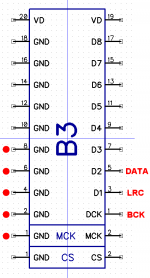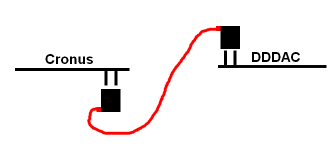Hi Francolargo,
thanks for your response!
I discussed it already with Miero, and so I think this is not a software problem. (But of cause I could also be wrong.)
I didn't touch the alsa config.
But how I understand it, if one tests all 8 channels in a stereo configuration, all of them should be part of either the right or the left channel
If ALSA thinks there are 8 channels it can default to 7.1-type routing. Thus, channel 4 •could• be blended as 'center'. I use B3se's and have no experience with the more general B3 but if it gave stereo before then I assume it is not a problem. I'm traveling with just my phone and can't give specific advice till I get home. If you need help in a few days, ask over on the thread where ALSA questions are common: http://www.diyaudio.com/forums/twis...rs-digital-crossovers-bbb-12.html#post4631927
Hi Frank,
thank you again for your time you used to respond!
I re-read your post, and will quote a passage here:
Second part: I didn't touch it.
And I also don't know, how it should look like.
So, I just wait here until you come back, because I don't want to spam the other thread over there, at least until you say that the solution lies within the alsa config.
Thank you!
Matthias
thank you again for your time you used to respond!
I re-read your post, and will quote a passage here:
First part: YesBotic/BBB can render 8 channels of PCM, but it seems you want only basic 2-channel stereo into the B3, correct? Have you configured ALSA in Botic for more than two channels?
Second part: I didn't touch it.
And I also don't know, how it should look like.
So, I just wait here until you come back, because I don't want to spam the other thread over there, at least until you say that the solution lies within the alsa config.
Thank you!
Matthias
XMOS WAVEIO I2S INTO HERMES
I've identified the pins for i2s from BBB into the Hermes.
I'd like to try pulling off the BBB connector and plug in the
the i2s outputs from the WAVEIO into the Hermes.
Is this possible or is there a voltage problem 'tween the
WAVEIO and Hermes? I see that the pcb for the Amanaro
has some sort of IC chip.
I've identified the pins for i2s from BBB into the Hermes.
I'd like to try pulling off the BBB connector and plug in the
the i2s outputs from the WAVEIO into the Hermes.
Is this possible or is there a voltage problem 'tween the
WAVEIO and Hermes? I see that the pcb for the Amanaro
has some sort of IC chip.
@ichiban
You can't use the waveIO with the Hermes/Cronus system.
The WaveIO can only work with its internal clocks (it is the clock master, can't be configured as clock slave like the BBB or the Amanero).
The Cronus board needs to be the clock master, feeding the source.
Hello Russ / Brian,
is there any new timeline the "Hermes-BBB Isolator Module" will be available again? The module is out of stock since last October.
Hans
I just marked them as in stock. Boards are arriving tomorrow, and I will start building modules right away.
Battery
Sent from my MHA-L09 using Tapatalk
Que?
Sorry Tapatalk screw up. Could not delete messageQue?
Sent from my MHA-L09 using Tapatalk
For the DDDAC, you need to ensure that BBB uses bitclock = 64 * frequency sampling and limits to 24 bit audio. (because of the DDDAC mainboard's hardware conversion from i2s to right justified)
Thanks! I'll check for that when I'm ready to test it. Is this in the uEnv.txt?
Sorry, I don't have a BBB...
Bitclock = 64 * fs should be default value.
http://bbb.ieero.com/
Don't know about bit depth, maybe in alsa config (or audio player like mpd or whatever you'll use)
Bitclock = 64 * fs should be default value.
http://bbb.ieero.com/
Don't know about bit depth, maybe in alsa config (or audio player like mpd or whatever you'll use)
Sorry for stupid questions – but; I know some has connected Cronus to DDDAC successfully, but how?

- Which pins on the Cronus do I use if I don't want to use uFL?
- Should I solder a female header on the end close to the uFLs and 'plug' some jumper cables in there?
- Do you, if that is the case, solder on male headers on a single cable?
- And should that cable be anything thicker/better than completely regular jumper cables?
- What is the difference in synchronous/asynchronous in terms of wiring?
- And if I understand correctly, async is the way to go?
- Is this then for I2S?
The 4-pin terminal block can also be used for output; if you decide to mount it, I suggest mounting it under the board to allow access to the u.fl connectors.
For the DDDAC, you need Bitclock (BCK), Left Right Clock (LRC) and DATA. And Ground.
With your DDDAC mainboard, you should have received a short female/female ribbon with 10 pins headers.
On the Cronus, I use the "B3" header, with male headers pointing UNDER the Cronus board.
Only the 3 used signals on one side, and the 5 ground pins on the other (check the first attachment)
This way, you can connect the ribbon like on the second attachment.
I hope it's not too obscure
With your DDDAC mainboard, you should have received a short female/female ribbon with 10 pins headers.
On the Cronus, I use the "B3" header, with male headers pointing UNDER the Cronus board.
Only the 3 used signals on one side, and the 5 ground pins on the other (check the first attachment)
This way, you can connect the ribbon like on the second attachment.
I hope it's not too obscure
Attachments
By the way, what do you mean with those questions:
It is the clock master, feeding a slave source, reclocking on the same master clock then feeding a slave DAC (which DDDAC is).
Not sure what you were asking here
Cronus is synchronous in its principles...
- What is the difference in synchronous/asynchronous in terms of wiring?
- And if I understand correctly, async is the way to go?
It is the clock master, feeding a slave source, reclocking on the same master clock then feeding a slave DAC (which DDDAC is).
Not sure what you were asking here
- Home
- More Vendors...
- Twisted Pear
- Hermes-BBB/Botic cape for BeagleBone Black

